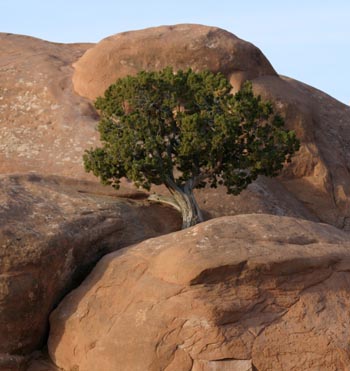Utah Juniper

Common Name(s):
Utah Juniper
Cedar
Scientific Name:
Juniperus osteosperma (Torr.) Little
Scientific Name Synonyms:
None known
Symbol:
JUOS
Description:
Life Span: Perennial
Origin: Native
Season: Evergreen
Growth Characteristics: Utah juniper is usually a bushy tree in appearance, with a rounded crown and a trunk that is many-forked or occasionally with a central dominant trunk. It has an extensive root system the enables it to vigorously compete for moisture. Mature trees are usually less than 30 feet high. Utah juniper can live to be 650 years old. Reproduction is by seed.
Flowers/Inflorescence: A small, up to 1/3 inch diameter, berry-like, globe-shaped female cone with poorly defined cone scales. These berries mature in 2 years and when mature are red or reddish-brown and covered with a whitish bloom. Both male and female flowers are found on most trees, resulting in the production of seeds on all trees. The male cones appear as tiny brownish overlapped filaments near the twig tips.
Fruits/Seeds: Seeds are usually borne one to a cone, rarely two. Each seed is somewhat long, pointed on one end and marked on the blunt end with a large dark area that covers nearly half of the seed.
Leaves: Scale-like in opposite pairs, small (about 1/8 inch long), giving the foliage a more coarse appearance than Rocky Mountain juniper. Awl-shaped leaves are common on terminal twigs and juvenile plants. Leaf surfaces lack a tiny glandular dot and margins that are finely toothed.
Stems: Twigs remain covered with overlapping leaves for several years. The bark is gray to reddish, fibrous, and shred into long strips along the stem. It may be an inch or more in thickness on old trunks. The wood is soft, light in weight, with light yellow-brown heartwood and a broad outer band of whitish sapwood. This wood is very durable, especially the heartwood.
Ecological Adaptions:
Utah juniper is common on dry plains, plateaus, and the lower elevation of the mountains of the state. Its elevation ranges between 4,000 and 7,500 feet. It is common in elevations below pinyon pine, and above the sagebrush-grass zone.
Across the West, junipers have expanded their historical range in the years since European settlement, especially into sagebrush-grass communities below areas of traditional pinyon-juniper. Overgrazing, fire suppression, and climatic change have been identified as potential causes of juniper invasion. In the absence of fire or other disturbances, trees eventually dominate the site and crowd out herbaceous and shrub species.
Soils: Utah juniper commonly grows on alluvial fans and dry, rocky hillsides, with shallow, alkaline soils. Utah juniper is considered a "sodium-sensitive" species. Utah juniper is found on a range of soil textures, but most often on gravelly loams and gravelly clay loams with a pH range of 7.4 to 8.0.
Associated Species: Big sagebrush, Indian ricegrass, rubber rabbitbrush, curlleaf mountain mahogany, antelope bitterbrush, needle and thread, blue grama.
Uses and Management:
Utah juniper is the most predominant single species of trees in Utah as far as total cover is concerned; nearly one-fifth of the land area of the state is covered by Utah juniper. Juniper "berries," or berry-cones, are eaten by jackrabbits, foxes, and coyotes. Many bird species depend on juniper berry-cones for fall and winter food. The foliage is grazed by mule deer when other foliage is scarce and during periods of deep snow.
Utah juniper has long been used for construction, fence posts, firewood, pencils, Christmas trees, and other purposes. Utah juniper wood is highly decay resistant.
The cones were eaten by Indians.

